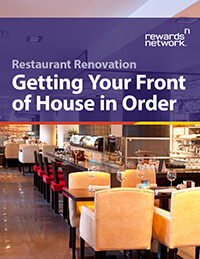While restaurant managers and servers split their time between front and back of house, your customer sits, waits, and looks around at your dining room.
Do they like what they see?
In our brand new report, we break down five areas of restaurant remodeling critical to keeping your customer happy — and coming back again and again:
- Seating
- Lighting
- Walls and Floors
- Soundproofing
- Bathrooms
Download this free eBook today to understand how restaurant remodeling for your dining room can help guarantee those most valuable return visits from your customers.
Excerpt from Chapter 2:
The time of day you’re open for service can be a touchstone for how you approach lighting your restaurant. If you open in the late afternoon and only serve dinner, sticking to a low intensity, softer light for atmosphere is key.
If you’re primarily a breakfast/brunch place, bright lighting can help set the mood for the day and give customers the light they need to read their newspaper with their morning coffee.
Lunch can be similar, with lighting that’s comfortable for the day crowd, but still vivid enough to encourage table turnover. You want customers to enjoy themselves, but not necessarily spend all afternoon at a table sipping water and reading a novel after finishing their lunch.
If you’re opening a breakfast or lunch restaurant for the first time, consider a location with large windows to take advantage of natural light in the mornings. When you serve the bulk of your customers during the day, windows can do half the work of lighting (and perhaps even cut electricity costs) compared to restaurants with less natural light.
However, even restaurants with expansive windows will need to be prepared with accent lighting for cloudy or stormy days, as well as with shading for super bright days.
A mistake many operators of formal dining establishments make is keeping their restaurant too dark. You can certainly to create a mood with your evening lighting, but be careful not to do it at the expense of visibility – and not just visibility at the tables, but throughout the entire dining room.
Dramatic atmosphere is important, but your guests still want to be able to see the menu. This is particularly important if your regular clientele is middle-aged or older. Ultimately, lighting that gets in the way of guests being able to order will not result in a positive dining experience.
Yes, style is a big part of decorating your restaurant. You want all the elements of your dining area design to be cohesive with each other, and that includes the lighting.
However, it can be easy to stumble when focusing on how a potential lighting fixture looks instead of how a fixture makes everything else look. Make sure whatever fixtures and bulb styles you choose are just as practical as they are stylish. It does no good to get a light bulb with the right brightness and color only to have your fixtures darken the room or seem radically out of place for your brand.
Electricity is a huge part of a restaurant’s utility bills. It can account for nearly 1/4th of a restaurant’s energy costs. Conventional incandescent bulbs and halogen lamps can also generate a lot of heat. This can not only make your guests and employees uncomfortable, but will also increase your air conditioning and electricity use to compensate.
With that in mind, investing in energy efficient bulbs for your lighting can be a great way to trim down that utility bill. LEDs lights are an option for both the front and back of the house. They do cost more upfront than conventional bulbs, but they last much longer, saving you money in the long run.
Check out restaurants doing it right.
A good exercise for any business owner is to keep an eye on trends and successes in their industry and local area. The next time you’re dining out at a restaurant (especially one similar to your own), pay attention to the lighting. Does it create the appropriate mood? Does it add to the dining experience or does it detract from it?
More than that, when you find yourself eating in a restaurant that has great lighting, how is it set up? Where are the light sources installed? What sort of color do the bulbs generate? Make note of these details so you can incorporate them into your own restaurant.
We’ve often noted how reaching out to your fellow local restaurateurs for networking and knowledge-sharing can bring a whole new level of insight to how your approach handling your financial challenges. The same can apply to advice on any renovation or FF&E decision. Connect with nearby restaurant owners, especially ones with long careers in the restaurant industry, and ask about how they’ve handled lighting issues.
It’s very possible that they’ve going through the same struggles you have with lighting their own restaurant and came up with the solution. They may even have a great referral for wholesale fixtures that can save you money. At the very least, simply chatting with your peers can help bring some frame of reference to your lighting options, and open up possibilities you may not have thought of on your own — and just about lighting.
